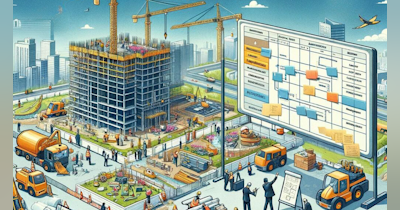In construction, we inherit a lot of expectations. We expect people to do their jobs based on role, title, contracts, previous training, and it's a bonus to get all that with a positive attitude. We expect our customers to pay us a fair price for our work, and our companies also expect us to earn a reasonable profit. All construction professionals, whether you grew up in the construction industry only in the trades, college to management, or a mix, keep learning on both sides of the construction job site fence. Over the years, think about how your team and organization benefited from your learning. Learning is priceless, and some ways pay back dividends faster than others.
No matter your role in the industry, we all have the same 24 hours each day to impact and change the built environment. Time is the great equalizer and ever-present constraint to manage. Since you are here, your philosophy likely aligns with mine in that we respect people, our work and dislike wasting our efforts or resources. Before I learned about Lean Construction, I typically worked seven days a week. After I learned how to see my work in three categories, I stopped working nights and weekends and delivered twice as much value to my team and building owner.
| Work Categories | |
| Value-Added | 🟢 Work that clients and supply chain partners want, appreciate, or pay for. |
|
Non-Value-Added but Necessary |
🟡 Work that does not add value to a product or service from the client's perspective, but occurs for a reason such as following a policy. |
| Non-Value-Added, Pure Waste | 🔴 Work that consumes resources, but does not add value to the product or service. |
After I learned about Scrum, my life was never the same again. In quick order, I became an international keynote speaker, a proven business leader guiding individuals, teams, and organizations in easier, better, and faster value delivery across the construction industry. Last year, I invested in my learning. I was honored to become a Registered Scrum Trainer™ (RST) in a partnership with the Agile Education Program powered by Scrum Inc.™, helping new construction professionals through The EBFC Show podcast, Blogs, social media, interactive education programs, and conferences.
Case Study: Construction Scrum Boosting Productivity by Over 200%
Here are three steps you can take now to make a high-return investment on your time today.
- Connect with me via social media using this link for the medium of your choice: http://thefelipe.bio.link. I share and showcase people from around the construction industry working to make building easier and better every week.
- Embrace an agile mindset. Agile is the ability to create and respond to change. Experiment with it. The next time you face uncertainty, try something you think might work, get feedback, and adjust accordingly.
- Repeat step two daily.
As you experiment and learn, your capacity for more learning increases and begins to compound. Your effectiveness and efficiency will start to increase. If you want to see a few case study examples and more priceless resources, check out this Scrum blog post: What every lean project team should know. Based on the theory that human beings learn by doing, Scrum practitioners accept that change is guaranteed. Our knowledge changes with experiences involving sensory information and thoughts. Even adopting some parts of the Scrum framework will improve your impact, time, and ability to adapt faster with certainty.
Scrum is a lightweight framework that enables people to deliver value through adaptive solutions for complex problems. Making a Scrum board is an excellent place to start with Scrum. Sticky notes or digital solutions matter less when starting. Low tech is faster to start when learning. There is slightly more to it than this, but following this will dramatically increase your weekly throughput. Keep the above three steps in mind.
Five Steps to Start using Scrum Now
Sample Scrum Board
- Agree to practice patience with yourself during this experiment and do one thing at a time. Multi-tasking is a myth. Look it up or wait to argue with me in person. It is more fun for me that way.
- Commit to achieving a goal this week. Please write it down and put it on the top of the Scrum board to keep it visible all week. See the Sample Scrum Board above.
- List three to five tasks that you think will help you achieve the goal. Make each sticky note get a single idea. A good practice is to keep tasks sized so that you can accomplish the tag action in a single workday and not so small that it could be finished in less time than to brew a pot of coffee.
- Prioritize the tasks in the "To Do" list. Put first things first. Reserve the top of the column for the top priority. Subsequent tags in the stack visually indicate descending priority order. The bottom of the column is for necessary yet less important now tasks. Tags closer to the “Doing” column are higher priority. The “Read the Scrum Guide” tag in the Sample Scrum board above would be done last.
- Move tags from left to right. When you work on the top priority item, place it in the "Doing" column. If you get substantially interrupted or change your mind, move it back to the left. Move the action to "Done" when the work is complete for that tag.
That's a good start. You will learn a lot just by doing those five steps. I started similarly with Scrum as project manager on a traditional hard bid project. I was able to daily complete my PM work, walk the project, attend meetings, upskill with my team, and volunteer on several committees. Don't do a bunch of research or jump to classes. Experiment and use the added capacity to do more of what you want.
Are you working with Scrum to deliver more value with less effort and have more fun? Check out these Scrum training resources to help you and your team(s) achieve twice the work in half the time.
Using Mural to Start Construction Scrum |
Registered Scrum Master Self-Paced Course |












